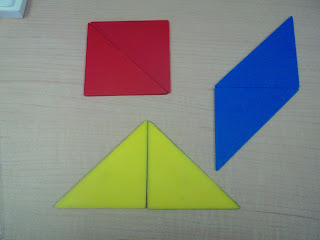 I have been growing more and more fond of tangrams recently. I used to think they were just for making pictures that might (or might not) look like a man on a sledge (right).
I have been growing more and more fond of tangrams recently. I used to think they were just for making pictures that might (or might not) look like a man on a sledge (right). Now I use them for exploring geometric properties and also for some proportional reasoning problems. Recently I went into a Grade 3 class and, to get them used to the tangrams, we began by telling them story of how tangrams were invented (as told in Virginia Pilegard's book The Warlord's Puzzle.) Basically, a special tile that was made for a VIP fell and broke into seven pieces. Many people tried to fit the pieces back together to make a square but with no success. Then came along a little boy who solved the puzzle and achieved fame and fortune (Hollywood should really make a film about this).
Now I use them for exploring geometric properties and also for some proportional reasoning problems. Recently I went into a Grade 3 class and, to get them used to the tangrams, we began by telling them story of how tangrams were invented (as told in Virginia Pilegard's book The Warlord's Puzzle.) Basically, a special tile that was made for a VIP fell and broke into seven pieces. Many people tried to fit the pieces back together to make a square but with no success. Then came along a little boy who solved the puzzle and achieved fame and fortune (Hollywood should really make a film about this).I then asked the students to take the two large triangles and ask them what shapes they can make with these. Usually, it doesn't take too long before students come up with a square, a parallelogram and a triangle (as shown below).
But after a while we got these other shapes which begged the question: What are the names of these shapes?
It is so important that students can construct irregular polygons to help them truly appreciate geometric properties.
Our next puzzle was straightforward to present to them:
If the small triangle costs 10 cents, how much does the whole tangram cost?
Occasionally, we get some students say "70 cents" as they think each piece is 10 cents; we reply to this by asking why the smallest piece would cost the same as the largest piece. The reasoning and proving, reflecting, representing and communicating that came out of this problem was great to see as seen in the video below:What I love about tangrams is that, given the right questions, students really do use them to help model their thinking. They also get students thinking about how shapes can be decomposed and recomposed. This is an essential skill that will come in useful later when they work with areas of irregular shapes.
And next time you make a toasted sandwich, how about you tangramise it?!



No comments:
Post a Comment